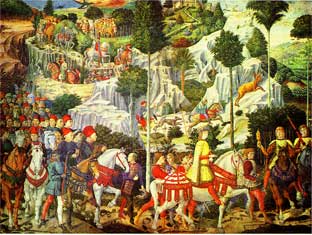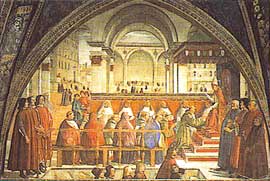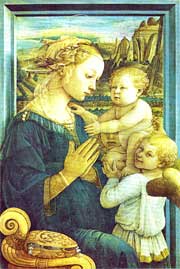Italian Renaissance Artists
The leading Italian Renaissance artists of the Quattrocento were, without a doubt, Brunelleschi, Ghiberti and Donatello. They were followed by a large group of sculptors, painters and architects, all of whom, whether pupils or not, were under their influence.
MichelozzoMichelozzo fluctuated between sculpture and architecture, but finally decided for the latter, and, together with Brunelleschi, is the great reviver of the classical style. He worked with Ghiberti on a St. Matthew and a tabernacle for Orsanmichele, and with Donatello on the tomb of John XXIII in the Baptistery.

Benozzo Gozzoli: Chapel of the Magi
Palazzo Medici Riccardi, Florence
But this Renaissance Italian artist is chiefly remembered as the architect of the Medici (now Medici Riccardi) Palace, of their three villas of Caffagiolo, Nozzi, and Careggi. The latter is the most beautiful of all and the one in which Cosimo and Lorenzo both lived and died; and also for the Chapel of the Annunziata, and for the complete reconstruction of San Marco, where Michelozzo is buried.
Desiderio da SettignanoDesiderio da Settignano only lived to the age of thirty-five, but his monument to Carlo Marsuppini, Greek scholar and orator, is one of the three finest tombs in Tuscany. The second is the one by Bernardo Rossellini, erected for the famous Leonardo Bruni, Chancellor and historian of the Republic, a man universally admired and beloved. Both are in Santa Croce. The third tomb is that of Cardinal James of Portugal, who died in 1459; it is in San Miniato and is the work of Antonio Rossellini, Bernardo's brother.

Domenico Ghirlandaio:
The Confirmation of the Order of Saint Francisc
by Pope Honorius III.
Holy Trinity, Florence
Another great tomb is that of Bishop Salutati in the Duomo at Fiesole, which is by Mino da Fiesole; nor do these names nearly exhaust the number. The della Robbias, uncle and nephew, are of course in the tradition of the great sculptors; to Luca, in conjunction with Michelozzo, we owe the bronze gates of the Duomo sacristy, and also the organ-gallery which was the companion to Donatello's.
A striking characteristic of the Renaissance artist was his versatility, and the Italians are the best examples. Antonio Pollaiuolo and Andrea Verrocchio were nearly as proficient in painting as in sculpture, and worked using every sort of material: wax, wood, enamel and silver.
Ghiberti employed Pollaiuolo on a festoon round the bronze gate of the Baptistery. Eventually Antonio devoted himself entirely to painting, but all his work witnesses to his study of anatomy, which often results in the portrayal of strained and awkward attitudes.
Andrea VerrocchioVerrocchio, who added to his artistic accomplishments that of being a musician, and who also gave himself over to painting, shows the same tendencies. Besides his pictures, he created magnificent sculptures. In Florence we can find his fine Christ and St. Thomas, his "Boy with the Dolphin," and his bronze David, both cast for Lorenzo de' Medici. Also the very simple but beautiful monument to Piero and Giovanni de' Medici in the old sacristy of San Lorenzo.
But he was in nothing as famous as in having Leonardo da Vinci as his pupil.
Italian Renaissance Painters
No other epoch saw such a galaxy of painters as the Italian Renaissance. Artists like Benozzo Gozzoli, Ghirlandaio and, especially, Botticelli, became the favorites of Lorenzo de' Medici.
Benozzo GozzoliA well known Renaissance painter, Benozzo was born in 1420. He was a pupil of Fra Angelico, and shortly before the death of Cosimo he had painted on the walls of the chapel of the Riccardi palace his gorgeous Procession of the Magi, which is the glorification of the Medici and their court. The third king is Lorenzo as a boy; Cosimo and his son follow behind, and further back the painter himself. In these frescoes, Benozzo Gozzoli gave free rein to his passion for elaborate and complicated background; he is remarkable as one of the first painters of detailed landscapes, wherein he used to place birds and animals of all kinds.

Filippo Lippi:
Virgin and Child with Angels
Uffizi, Florence
Ghirlandaio is the most modern and realistic of the three Renaissance painters mentioned above; he is an architectural painter and displays an intimate knowledge of perspective. What is chiefly the subject of his paintings is the life going on around him: the houses, the furniture, the people as they looked and dressed and walked.
Though by no means an uninspired painter, he is most valuable as an historical portrayer of the times. Also he loved to introduce portraits, and in one of his frescoes in Santa Maria Novella he has given us a group of four Humanists: Becchi, Poliziano, Landini and Ficino. As an artist he matured slowly, but by degrees he acquired the grand manner in treatment and composition.
But of all Italian Renaissance artists, Botticelli, the pupil of Fra Filippo Lippi, was the favorite of Lorenzo de' Medici. He was also, in some sort, the reflection of the genius of Lorenzo, and seemed to breathe the same atmosphere with him.